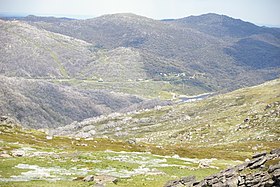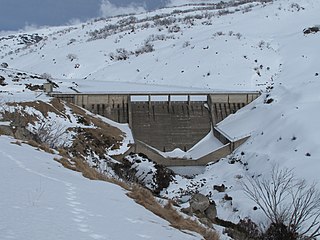| Mount Tate | |
|---|---|
 The view southeast from Mount Tate | |
| Highest point | |
| Elevation | 2,068 m (6,785 ft) [1] [2] [3] |
| Prominence | 188 m (617 ft) [1] |
| Isolation | 5.59 km (3.47 mi) [1] |
| Coordinates | 36°21′S148°21′E / 36.350°S 148.350°E Coordinates: 36°21′S148°21′E / 36.350°S 148.350°E [4] |
| Geography | |
Location in New South Wales | |
| Location | Snowy Mountains, New South Wales, Australia |
| Parent range | Main Range, Great Dividing Range |
| Climbing | |
| Easiest route | Walk (hike) |
Mount Tate is a prominent rocky mountain on the Main Range of the Snowy Mountains located in southeastern New South Wales, Australia.

A mountain is a large landform that rises above the surrounding land in a limited area, usually in the form of a peak. A mountain is generally steeper than a hill. Mountains are formed through tectonic forces or volcanism. These forces can locally raise the surface of the earth. Mountains erode slowly through the action of rivers, weather conditions, and glaciers. A few mountains are isolated summits, but most occur in huge mountain ranges.

The section of the Great Dividing Range between the Ramshead Range and Dicky Cooper Bogong in the Snowy Mountains is known as the Main Range. It can also be used more generally for the peaks on or on short spurs off the range. It contains many of the highest peaks in mainland Australia. Some peaks on the Main Range include :

The Snowy Mountains, known informally as "The Snowies", is an IBRA subregion and the highest mountain range on the continent of mainland Australia. It contains the Australian mainland's highest mountain, Mount Kosciuszko, which reaches to a height of 2,228 m (7,310 ft) above sea level. The range also contains the five highest peaks on the Australian mainland, all of which are above 2,100 m (6,890 ft). They are located in southern New South Wales and are part of the larger Australian Alps and Great Dividing Range. Unusual for Australia, the mountain range experiences large natural snowfalls every winter. Snow normally falls during June, July, August and early September, with the snow cover melting by late spring. The Tasmanian highlands makes up the other (major) alpine region present in Australia.
With an elevation of 2,068 metres (6,785 ft) above sea level, [1] Mount Tate has two ridges running north and south, named Tate West Ridge and Tate East Ridge, referring to the side of the Great Divide where they lie. It has views along the Main Range towards Mount Twynam and down to the Geehi Valley. [5]
The Australian Height Datum is a vertical datum in Australia. According to Geoscience Australia, "In 1971 the mean sea level for 1966-1968 was assigned the value of 0.000m on the Australian Height Datum at thirty tide gauges around the coast of the Australian continent. The resulting datum surface, with minor modifications in two metropolitan areas, has been termed the Australian Height Datum (AHD) and was adopted by the National Mapping Council as the datum to which all vertical control for mapping is to be referred."

The Great Dividing Range, or the Eastern Highlands, is Australia's most substantial mountain range and the third longest land-based range in the world. It stretches more than 3,500 kilometres (2,175 mi) from Dauan Island off the northeastern tip of Queensland, running the entire length of the eastern coastline through New South Wales, then into Victoria and turning west, before finally fading into the central plain at the Grampians in western Victoria. The width of the range varies from about 160 km (100 mi) to over 300 km (190 mi). The Greater Blue Mountains Area, Gondwana Rainforests, and Wet Tropics of Queensland World Heritage Areas are located in the range.

Mount Twynam is a mountain located on the Main Range, part of the Great Dividing Range, in the Snowy Mountains in New South Wales, Australia. The mountain is located close the border between New South Wales and Victoria.
The mountain is situated approximately 3 kilometres (1.9 mi) northeast of Guthega and southwest of Guthega Power Station. [3]

Guthega is a ski village and the site for a hydro electric dam located in the Kosciuszko National Park, on the upper reaches of the Snowy River, on the western face of Mount Blue Cow, Snowy Mountains of New South Wales, Australia.

Guthega Power Station is located in the Snowy Mountains region of New South Wales, Australia. The power station's purpose is for the generation of electricity. It is the first to be completed and smallest of the initial seven hydroelectric power stations that comprise the Snowy Mountains Scheme, a vast hydroelectricity and irrigation complex constructed in south-east Australia between 1949 and 1974 and now run by Snowy Hydro.












